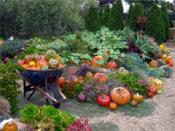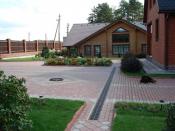Search
Login
Ornamental shrubs in the garden, planting ornamental shrubs
Creating an interesting garden composition is unlikely to do without the use of ornamental shrubs. Their bright leaves, bizarre, or vice versa, surprisingly correct outlines emphasize the beauty of trees and the tenderness of flowers, some of their species themselves delight the eyes with unusually lush flowering, densely planted shrubs create very practical hedges. But in order for decorative and deciduous shrubs to organically fit into the garden landscape, one should competently approach their choice, planting scheme and care.
Content:
- What basic rules should be followed when choosing plants for your site
- Minimize maintenance work
- Shrubs in different style gardens
- Ornamental shrubs traditionally grown in midland gardens videovideo
What basic rules should be followed when choosing plants for your site
To make a landscaped garden with your own hands always look perfect, you should correctly select plants, in particular trees and shrubs. The right approach to solving this issue will help to minimize the time spent on gardening, but garden compositions will have a fairly well-groomed appearance. Consider issues that require special attention.

decorativeness
First of all, you should determine how attractive the plant will look. The selection task is complicated by the presence in the horticultural market of hundreds of varieties of ornamental shrubs that delight the eye with an extremely bright color of foliage, an original form or incredibly bright flowers with a pleasant aroma.

If there is a desire to acquire flowering shrubs for giving, then you should pay attention to the duration of flowering, it is better to give preference to a plant with a long flowering period, throughout the spring-summer season.
Watch flowering shrubs video:
Minimize maintenance work
If you choose the right types of shrubs, then the care of decorative plantings can be simplified to a minimum, they will not need to be divided and transplanted annually, fed every two weeks, the life span is much longer than that of flowers. The main and most time-consuming task will be pruning shrubs. To simplify care even more, you can choose plants that in adulthood will correspond in size to the place that is reserved for them.

Simplifies the pruning process of planting compact, small cultivars. They are not aggressive against plants planted nearby, they are not inclined to grow to the sides, they are not very active in height.
By decorativeness, cultivars are not much inferior to perennial herbaceous plants, but are practically devoid of the disadvantages characteristic of them. Having thought over and once created a composition of such plants, it will be possible for many years to admire the results of your work - decorative-deciduous shrubs can replace a spectacular flower garden that requires careful care. The use of geotextiles as a mulching material will simplify care.

Perennial shrubs cultivars can be used:
- as green borders along walking paths,
- to create mixborders and islets on lawns,
- for a picturesque frame of an artificial reservoir,
- to decorate the gazebo, entrance to the porch,
- to refine the area near the gate.
Any idea of \u200b\u200bcreating a composition using miniature and compact shrubs is quite possible to realize with your own hands, and without much effort.

No less interesting option that landscape designers offer may be the creation of plantings with minimal care. It consists in the following: a beautiful ornamental shrub is planted in accordance with the developed scheme, but it is allowed to grow at its own discretion.
If traditional gardens of minimal care imply complete freedom for plants, the use of miniature cultivars nevertheless gives a greater degree of control over the shrubs planted according to the schemes. For this reason, it is possible to recommend a garden composition of compact hybrids even to those who love the perfect order, prefer neat paths and healthy, strong plants.

Nevertheless, gardeners will not be bored - living plants will not be able to be enclosed in a certain framework, their growth in any case will lead to the fact that the composition will change somewhat, although this will happen slowly and less noticeably. So, if desired, it will be possible to improve garden studies to your taste.
According to experts, planting compact forms of shrubs will help save time and energy, a garden ensemble created in accordance with modern trends will be another confirmation of the style and rationality of its owners, who, keeping pace with the times, were able to create a garden of original design and at the same time have time for other activities and leisure.
Shrubs in different style gardens
Ornamental shrubs and trees are the basis of landscape design. But the creation of a truly beautiful and stylish garden involves the use of planting schemes for decorative shrubs, using them you can create an original, seamless composition that is acceptable for any style decision.

The main task in this case are:
- the right choice of place for planting plants,
- landscape style definition
- selection of suitable varieties of ornamental plants.
features of the formation of a regular garden
This type of garden is characterized by rigor and order; planting of any plants is carried out in compliance with clear lines and strict forms. Moreover, this applies not only to the placement of plants, but also their shape. Shrubs of spherical, cubic, conical shape organically fit into the classic garden solution, i.e. It is advisable to choose plants that tolerate frequent haircuts.

High hedges can be formed from plantings:
- irgi
- barberry
- the turn
- small-leaved elm.

For low hedges, plants such as:
- berry yew
- golden currant
- privet,
- spirea,
- boxwood.
which plants to choose for a landscape garden
The landscape option does not impose stringent requirements either on the plants themselves or on their location. Designers recommend that when choosing plants, be guided by the rule of selecting plants for their decorativeness, in particular - the color of leaves, flowers and berries.

Perfectly fit into the landscape landscape:
- viburnum and hawthorn,
- spirea and Lilac
- mock and snowman,
- rosehip and vesicle.

These plants will decorate the garden with original shades of foliage, abundant flowering, and in the fall - bright berries.
how to form compositions
What role flowering shrubs and ornamental plants will play in the garden depends only on your desire; they can solo in the composition or serve as accompaniment, emphasizing the beauty of flower beds and large trees. But depending on the chosen point of view, these roles can radically change. This statement does not apply to hedges - in any case, it is an independent and monolithic element of fat.

With proper composition, you can visually increase the area - for this you will need to use low bushes. Picturesque landscapes will be given by plants disbanded in groups, emphasizing contrast and size. Low plants should be planted in large groups - only in this case they can produce the expected effect.
A very important point is to determine the right place for planting plants. For example, large coniferous trees should be planted at a distance of no less than 10 m from the general composition with shrubs and low trees.
It is advisable to compose the composition so that for every warm season there is flowering of at least several varieties of plants:
- Spring flowering can be provided by planting rose hips, azaleas, camellias, rhododendrons;
- Summer in the summer can be provided by: barberry, hydrangea, scoopia, garden hibiscus, bushy rose, weigel;
- Autumn flowering will please: hawthorn and panicled hydrangea, euonymus and heather, magnolia and abelia are cold-resistant, in addition, on some shrubs bright, eye-catching fruits will appear;
- The decoration of the conservatory will be the evergreen leaves: thorns, holly, turf, yew.
Ornamental shrubs traditionally grown in midland gardens
One should also not forget about the beautifully flowering shrubs traditionally used in garden plots.

The most common of these is rose flowerAlthough the plant requires attention and care, individual park varieties will be able to grow even those who do not have practical skills in caring for plants. Unfortunately, most varieties of roses bloom only in the summer, once a season.

Rose looks great when planting on a flower bed, it is no less attractive as a single plant on a bright green lawn.
Watch a video about what wonderful roses can be grown in the garden:
No less loved by gardeners jasmine, traditionally it is used to create malls or hedges. Jasmine is especially attractive during flowering, when millions of its white flowers exude a delicate heady aroma.

The shrub tolerates partial shade, but will grow and bloom more actively when planting in well-lit areas. Especially decorative are the varieties of jasmine with a vertical and pyramidal crown shape.
To create a vibrant hedge often use vesicle, whose foliage is painted in bright green and burgundy red shades, its extremely elegant white and pink inflorescences attract attention.

The shrub tolerates even severe winters. According to the design of the bush, the plant can be attributed to medium-sized.
An excellent candidate for a landscape garden is rhododendron, pleasing in summer with a scattering of bright flowers, and in autumn - no less picturesque berries.

Rhododendrons in a group landing are more effective.
Derain refers to tall shrubs, it attracts gardeners with long flowering, from May to September, a bronze-raspberry shade of leaves in the autumn, bright cherry-colored branches in the winter.

You can plant derain in group plantings as well as single.
Watch a video about the varieties of shrubs:





